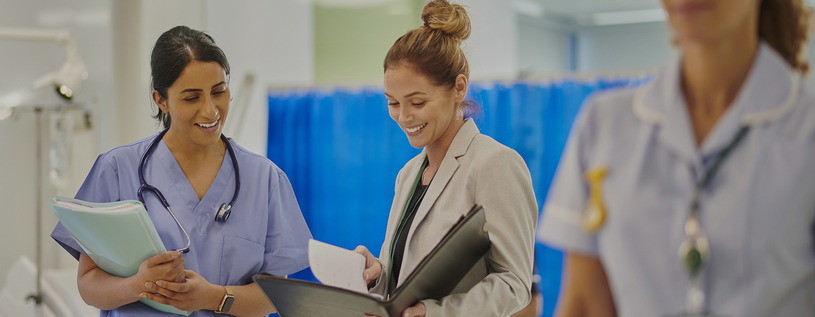Best Practices in Medical Management for Improving Effectiveness and Decreasing Costs
In the ever-evolving landscape of healthcare, the search of best methods in clinical management is vital for improving efficiency and suppressing expenses. By incorporating sophisticated technologies such as digital health records and telemedicine, medical care companies can improve procedures and enhance patient treatment. However, modern technology alone is not a remedy; enhancing resource allowance and fostering collaborative communication amongst care groups are just as vital (medical administration). As companies make every effort to balance top quality and expense, what approaches should be prioritized to accomplish these twin goals? The solution to these inquiries hold the secret to a more sustainable medical care system.
Leveraging Advanced Modern Technology
In today's rapidly developing health care landscape, leveraging innovative modern technology is no much longer optional but important for reliable medical administration. The integration of digital services right into health care systems has actually changed the way facilities operate, improving processes and enhancing client care. Electronic Health And Wellness Records (EHRs) are essential, giving thorough person information that can be accessed instantly by authorized employees, hence reducing redundancy and reducing errors. By centralizing patient details, EHRs remove the requirement for troublesome documents and assist in seamless communication amongst medical care carriers.
Telemedicine is one more technical innovation that has actually changed individual interaction. It supplies comfort for both patients and healthcare specialists by making it possible for remote assessments, which can minimize the need for in-person gos to and optimize visit organizing. Furthermore, telehealth systems can prolong medical care access to rural or underserved locations, connecting spaces in treatment delivery.
In addition, the use of Artificial Knowledge (AI) and artificial intelligence is ending up being increasingly common in anticipating analytics, allowing for early discovery of potential wellness issues and more enlightened decision-making. These technologies, when integrated successfully, can improve diagnostic accuracy and customize individual treatment plans, inevitably leading to enhanced health care outcomes and functional performance.
Optimizing Resource Allotment
By purposefully taking care of sources such as workers, devices, and finances, medical care facilities can dramatically boost their functional performance, improve patient outcomes, and lower unnecessary expenditures. The initial step in optimizing source appropriation entails carrying out a comprehensive evaluation of current properties and recognizing areas where sources might be underutilized or overextended.
Focusing on source allowance based on individual needs and service needs is important. This involves straightening resources with high-demand locations, such as emergency treatment or specialized treatments, to guarantee prompt and efficient patient treatment. Implementing adaptable staffing designs can additionally enhance labor sources by changing personnel allowance in response to rising and fall individual quantities. Furthermore, welcoming telemedicine and various other technological solutions can ease physical resource restraints by providing different avenues for patient-provider communications.
Funds must be diligently kept an eye on and alloted with tactical insight to sustain both short-term operational requirements and lasting institutional objectives. This includes investing in training programs that boost team competencies and adopting energy-efficient methods that minimize functional prices (medical administration). Inevitably, a maximized source allotment technique promotes a sustainable health care atmosphere that is responsive, reliable, and financially prudent
Streamlining Workflow Processes
When healthcare facilities aim to improve operational performance, streamlining workflow procedures comes to be a crucial emphasis. Effective process reduce redundancy, remove unneeded actions, and boost sychronisation among health care experts. This method not only accelerates solution distribution however also enhances the top quality of client care.

Following, modern technology combination plays a substantial role in enhancing operations. Executing digital wellness records (EHRs) and electronic physician order entrance (CPOE) systems minimizes documentation, reduces human mistake, and makes certain information is easily accessible to all pertinent personnel. weblink Furthermore, leveraging telemedicine systems can simplify client examinations and follow-ups, reducing the strain on physical facilities.

Inevitably, structured operations cause set you back decreases and enhanced individual contentment, cultivating a much more sustainable healthcare environment.
Enhancing Data Monitoring
Structure upon structured process, enhancing data management comes to be an essential part ahead of time health care management. Effective data management systems are essential for maintaining exact individual records, improving decision-making, and ensuring conformity with regulative requirements. By executing robust information administration solutions, medical care centers can enhance the top quality of patient treatment while all at once minimizing operational expenses.
One key facet of improving information administration is the assimilation of sophisticated digital health document (EHR) systems. These systems promote the seamless exchange of patient details throughout various departments, minimizing duplication of examinations and reducing errors. A properly designed EHR system supports information analytics, enabling medical care carriers to determine fads and make informed choices concerning person care.
In addition, protecting person data is critical. Taking on thorough cybersecurity steps, consisting of encryption and routine audits, makes certain the integrity and privacy of delicate details. This not only safeguards people but likewise preserves the establishment's track record.
Buying staff training is an additional essential variable. Informing medical care professionals on data monitoring techniques boosts their capability to effectively utilize innovation, bring about boosted patient outcomes. To conclude, enhancing data administration with sophisticated innovation and thorough training is important for accomplishing effectiveness and expense reduction in medical administration.
Fostering Collaborative Communication
A vital element in progressing medical administration is fostering collaborative interaction amongst medical care experts. Efficient communication is vital for ensuring smooth person treatment, enhancing treatment outcomes, and my response decreasing mistakes. By motivating open dialogue and control throughout multidisciplinary groups, healthcare companies can improve their operational efficiency and reduce unneeded expenses.
Central to this strategy is the integration of interaction modern technologies such as digital health documents (EHRs) and safe messaging platforms, which facilitate the quick exchange of important individual info. These tools make it possible for doctor to access and share information in real time, ensuring that all staff member are educated and lined up in their decision-making processes. Normal team conferences and interdisciplinary rounds can even more advertise a culture of partnership and accountability.
Educating programs concentrated on improving communication abilities are also crucial. These programs can assist team establish the capacity to convey details clearly and pay attention proactively, thus lowering misunderstandings and cultivating a helpful workplace. In addition, embracing standard communication procedures, such as SBAR (Scenario, History, Assessment, Suggestion), can simplify the exchange of information, making certain that vital information are shared succinctly and effectively. Eventually, promoting joint interaction leads to improved healthcare delivery and expense savings (medical administration).

Final Thought
Incorporating sophisticated innovation, such as electronic health records and telemedicine, alongside optimized resource allocation and structured operations procedures, is vital for boosting effectiveness in clinical administration. Effective data monitoring and cultivating joint interaction among health care teams are important for reducing redundancies and improving care top quality. By focusing on precautionary care and taking part in high quality renovation initiatives, healthcare organizations can attain considerable cost financial savings and boosted client outcomes, therefore making sure sustainable health care delivery in a progressively intricate atmosphere.